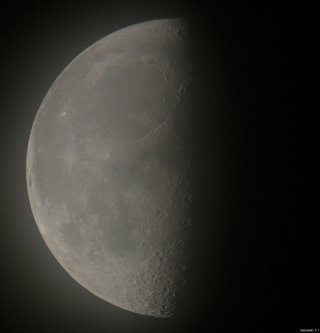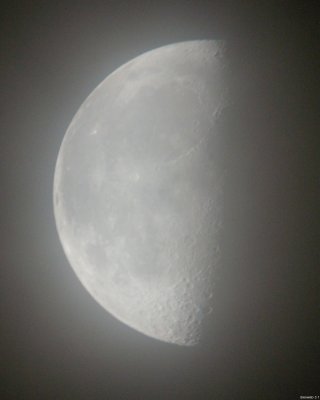In an earlier post I went into the motions of the moon in some detail. Not the orbital mechanics, or even the libration; just the apparent position of the moon throughout the monthly cycle and throughout the year. If you recall, the first quarter moon near the March equinox is at maximum elevation above the horizon. Correspondingly, the last quarter moon near the March equinox is at minimum elevation above the horizon.
This morning we are about six weeks away from the March equinox. And at the time of the image below (3:50 a.m. EST), we were about 13 hours away from the time of official last quarter phase (6:49 p.m. EST tonight). So the moon was about 8 percent above the lowest it will get all year. Which means there is a LOT more of Earth’s atmosphere between us and it than there was two weeks ago, when the first quarter moon was about 8% below maximum elevation for the year, or last week, when the full moon was in about the same position.
See, that’s the funny thing about the lunar cycle: in some months, the full moon and first quarter moon (only 1 week distant in time) appear in hugely different parts of the sky. In October, for instance, the full moon is about halfway between mean and maximum elevation, while the first quarter moon is just about at minimum elevation. A graphic would be very helpful here, but I’m not skilled in computer graphics; there’s an excellent chart of all four major phases of the moon and their relative position above the horizon in Rükl’s Atlas of the Moon. There’s also a good explanation of lunar angles on the website of the Royal Astronomical Society of Canada. So until I figure out how to draw graphs on the computer, please use those resources.
[UPDATE: Today I learned how to plot graphs in Excel, export them to Illustrator, and create a .gif that, while not pretty, at least conveys a bit of the information I want you to see:
[End UPDATE]
Anyway, since the moon was so low above the horizon, that meant that I had to image through quite a bit of atmosphere to get this morning’s moon shot. Furthermore, there was a great deal of water vapor in that atmosphere, in the form of clouds. At no time did I get a good clear view, although the moon was technically “visible” for most of the time I was attempting to observe it. Saturn was also visible, by this bare definition, but not a single star could be seen.
The presence of all this moisture in the atmosphere had a bit of a scattering effect on the light; not only did I have to increase my exposure time to compensate for the lower light the moon gave off naturally (at only 0.57 illuminated), but I had to add time for its height above the horizon and the obscuring clouds. The results of which you can see below; I post the photo purely for the historical record:
I’m not even bothering to make a labeled map for this image; hopefully I’ll have better luck tomorrow. The reason I was excited to try today at all is that the moon is at maximum latitudinal libration for the month right now; its northern hemisphere is tilted toward us almost a full 7°, so I would have been able to see quite a bit of detail up there in that region. (The moon is also “fully tilted” in longitude, but since it’s the eastern limb, currently dark, that is tilted toward us, it’s rather less interesting to investigate.) Oh, well. Yesterday’s image is at roughly similar libration, so all is not lost.
Just for fun, I post below a completely unprocessed image (just rotated and cropped) so you can really see the effect of the clouds.
The exposure time was twice as long as for the “good” image, but details are still only barely visible, and the halo effect is quite intense.
Some days, it hardly pays to crawl out of bed early!




